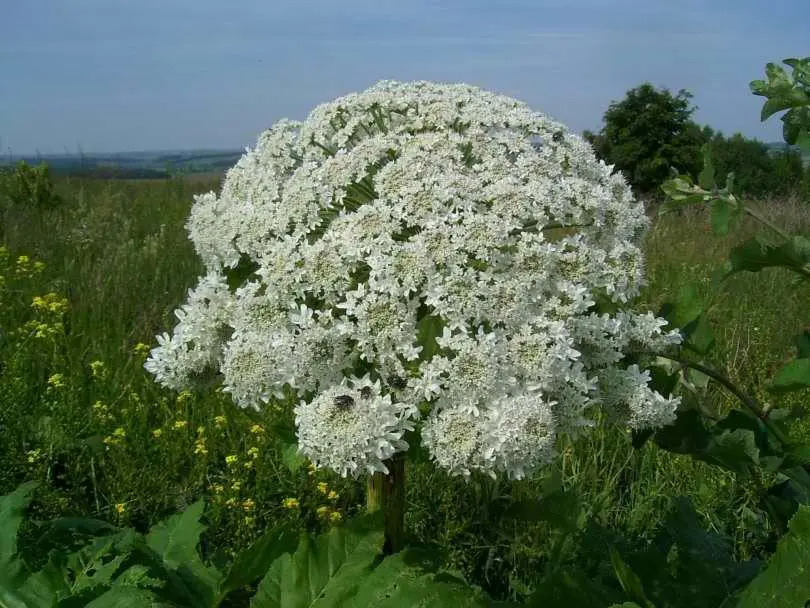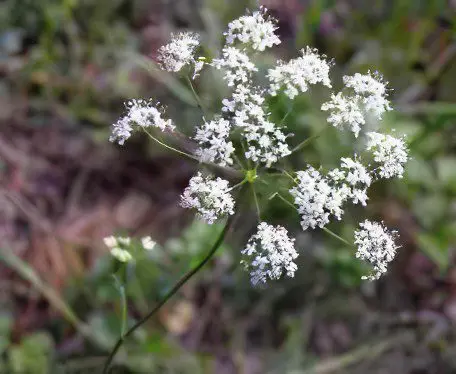Contents
Properties of hogweed – a poisonous plant, burns from hogweed
Botanical characteristics of hogweed

Borschevyk is a perennial plant with a powerful hollow, ribbed stem that grows up to 150 cm, and in Latvia it can reach 3 meters in height. The stem is covered with stiff hairs, the branches are in its upper part. It has a pleasant, slightly perceptible spicy smell. The plant has a powerful root system, has large leaves that grow about half a meter in length. The petioles are stalked and, like the stem, are covered with scales. The upper surface of the leaves is smooth, hairiness is noted along the midrib.
The plant blooms in June-July. White flowers are collected in a large umbrella. The fruits of hogweed (dvuzernovka) appear in August. Hogweed grows in central Russia, in Siberia, in the Urals, in the Caucasus, in Udmurtia, in Altai. There are about 70 species of hogweed. This plant is able to propagate by self-sowing
Hogweed – a poisonous plant
Some types of hogweed are poisonous plants that can even damage the human respiratory system. They can be found in the fields, in household plots, on the banks of reservoirs and in wastelands. The cow parsnip poses the greatest danger in the summer. Severe allergies can be caused by the smell, pollen and sap of a poisonous plant, and there are cases when people have received toxic poisoning. The coumarin and essential oils contained in the plant contribute to the formation of burns when touched. Subsequently, painful conditions can be observed, accompanied by nausea, vomiting, headache, dizziness.
During flowering, hogweed is especially dangerous. The juice of the plant, getting on open areas of the skin, increases its susceptibility to the sun’s rays, under their influence burns appear, and then blisters. Hogweed poses a huge threat to people prone to allergic diseases, the reaction can be the most unpredictable. You need to be more careful and not touch this incredibly beautiful plant, both adults and children should be warned about this.
More: How to distinguish poisonous hogweed from edible?
Siberian hogweed
Siberian hogweed does not stand out for its violent growth, it is harmless, it can be seen in many regions of our country. The flowers of the plant are yellowish-green, collected in large complex umbrellas. It has small egg-shaped fruits. This type of hogweed does not pose any danger to human health, since it contains very few coumarins and essential oils and they are distinguished by a sensitizing effect.
Before the advent of cabbage, the roots of hogweed were boiled, salted and consumed in a sauerkraut form, this plant tastes like cabbage. The roots and fruits of Siberian hogweed contain essential oils, carotene, vitamin C, tannins. The seeds contain octyl alcohol. Siberian hogweed is an excellent medicinal plant, on the basis of which you can prepare all kinds of remedies that are useful for the body, which have a calming effect on various nervous disorders, convulsions, and epilepsy.
Common hogweed

Herb hogweed is a large perennial plant that grows in Europe and Asia. Valuable are the seeds of the plant, containing oil with a pleasant aroma. Acetic acid octyl ester was found in the oil. The composition of the oil of leaves and flowers contains aldehydes, which form alcohol when the seeds ripen.
Hogweed oil easily soluble in strong alcohol, this liquid is used to obtain octyl alcohol. Hogweed seeds have a calming and anti-inflammatory effect.
The infusion is prepared at the rate of 1 tsp. hogweed seeds in 250 ml of boiling water. The product is infused for 1 hour. It is recommended to drink it 1/4 cup 4 times a day for stomach cramps and women’s ailments.
With diarrhea, dysentery, gastritis, enteritis, edema, it is recommended to take 20 drops of hogweed extract. To prepare it, you need to insist 100 g of fresh crushed hogweed plant for 7 days in 200 ml of 96% alcohol. For muscle spasms, coughs, skin problems, take 10 drops 2 times a day.
Hogweed properties
Since ancient times, hogweed has been famous for its medicinal properties. Due to the presence of furocoumarins, the plant has a bactericidal effect, so it is used to treat animals for helminths. As a raw material, cow parsnip is used to obtain psoralens – effective substances that are suitable for the treatment of psoriasis.
Hogweed flowers contain a lot of pollen and nectar; this is a honey plant. The juice of the plant was used in the treatment of ulcers and purulent wounds, in asthma and epilepsy. The roots have been used to make potions for liver pain and to recover from jaundice. Hogweed is characterized by fodder properties. The plant contains carbohydrates, proteins, vitamins and trace elements. Zinc, copper, manganese, iron, calcium allow this excellent plant to be used for combination with other crops in the production of silage for cattle. Hogweed leaves are rich in chlorophyll, carotene, tannins and essential oils. Cooked food using hogweed has a pleasant vegetable taste and smell.
Burns from hogweed (poisonous)
Sosnovsky’s hogweed – refers to poisonous medicinal plants, can cause inflammation of the skin, similar to sunburn. Plant sap and pollen damage can occur not only through unprotected skin contact with it, but also through clothing. When going out into nature, it is necessary to protect yourself from a possible unpleasant meeting with a useful and at the same time dangerous plant.
Watch a video on how to distinguish Siberian hogweed (harmless) from pine (poisonous):









